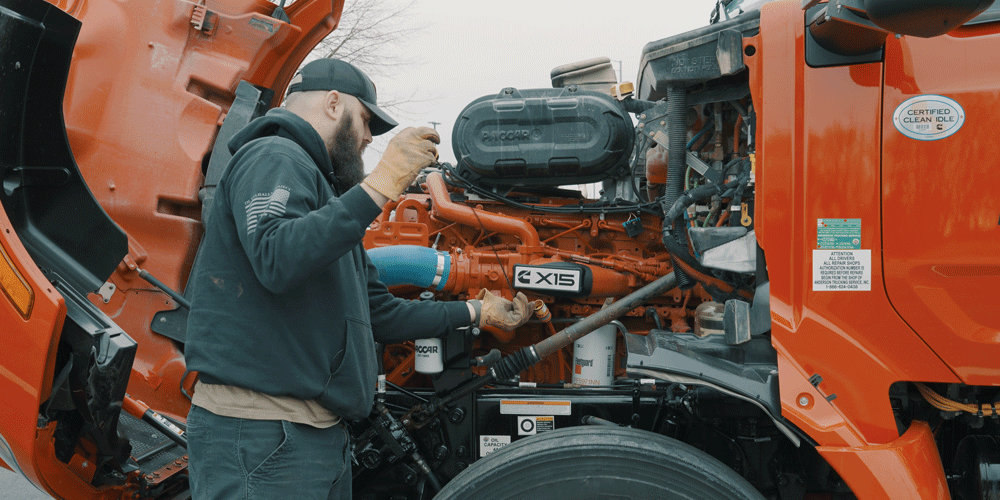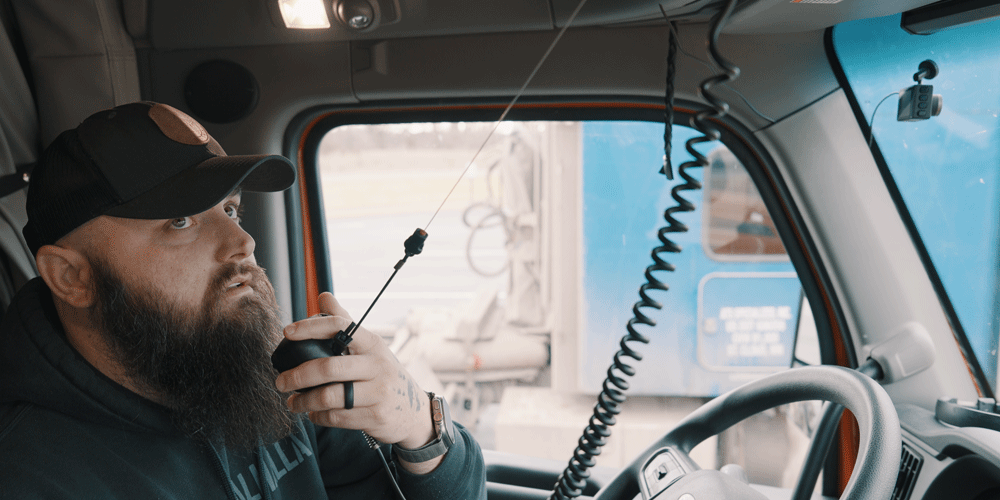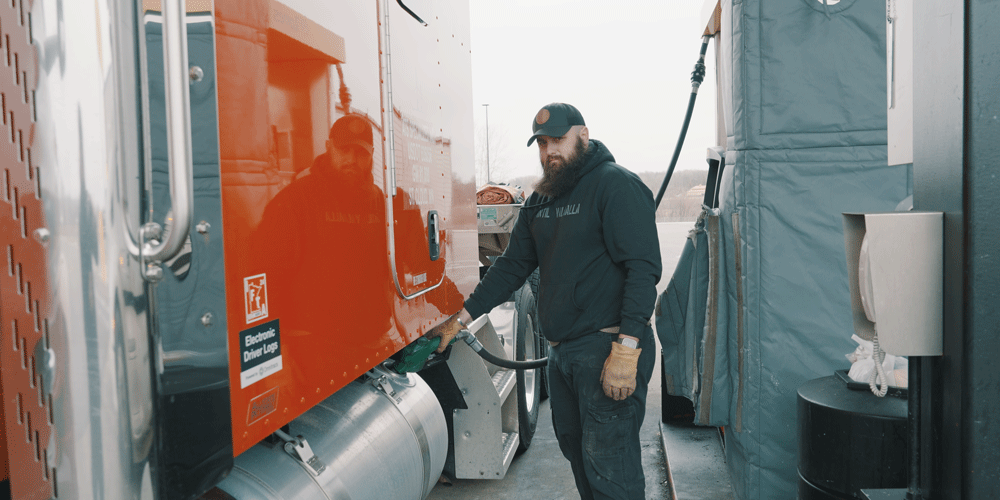Robert has been in the trucking industry for more than a decade. He's been a flatbed driver at ATS since 2021.
Ever wonder what it’s like to be one of those drivers going down the road pulling an oversized load? I’m talking about anything from large concrete slabs to excavators to massive coils.
Well, now’s your chance.
Getting into the flatbed world is equally as rewarding as it is challenging. If you join a great flatbed training company, you’ll get the training you need to be successful, along with the support you need to keep growing your skills.
But there’s still so much you’ll learn as you go. It’s a job that requires you to always be alert, always be on your toes, and never get comfortable. The second you do, mistakes can happen. This is a job you need to make sure you’re ready for before you dive in.
My name is Robert and I’m a flatbed driver with Anderson Trucking Service (ATS). I’ve been driving for over a decade and I’m here to help you understand what my job consists of so you can decide if it’s right for you, too.
Morning: Starting My Day and Pre-Tripping
As a flatbed driver, I typically have no reason to drive overnights because shippers/receivers aren’t open for pickups and deliveries, so I start my day early in the morning.
Wake Up and Self-Care
When I wake up in the morning, I always give myself some time to truly wake up. I never get up and start driving immediately.
Take some time to clear your head, hop into the truck stop to take care of your business, and get yourself set up with some coffee (if you drink it), water, and a healthy meal to start the day. I like to cook meals in my truck and keep healthy snacks in my refrigerator to keep me properly fueled all day.
Pre-Trip Inspection
After I’ve taken care of my personal needs in the morning, I do a pre-trip inspection. Pre-trips are important to do every day and every time you stop to take a break or reset. A thorough pre-trip takes me upwards of 15 minutes.
I make sure my truck and trailer are good to go before I move forward. Doing so ensures I don’t end up with an unexpected breakdown midway through my trip or get pulled into a scale and receive a violation because something on my truck wasn’t up to regulation.
Trip Plan
Every day varies, so I may or may not be under a load. I may wake up and need to get to a shipper to pick up a new load or I might be continuing my two- or three-day journey across the country for a delivery.
Either way, I review my trip plan before I start driving. I can only drive about 600 miles each day, so I make a plan based on where in the country that’ll get me. I plan where I can stop for fuel and breaks on the way to a shipper or receiver. I’ll also come up with a few parking options. Check out these parking tips.
If I’m off to pick up a load, I’ll review the load description before I start driving. That helps me mentally prepare for what I’m going to be securing or hauling. Maybe it’s something I’ve hauled before and it’s no big deal, or maybe it’s equipment I’m unfamiliar with.
I also might have to switch trailers for the load, so I plan that stop in too.
As a seasoned driver, trip planning doesn’t take up too much of my time. I know the interstates well so I know the general whereabouts of truck stops and rest stations. If you’re a newer driver, trip planning may take you longer. Seasoned as I am, this still isn’t a step I’ll skip.
Connect with My Driver Manager About Loads
Day to day I connect with my driver manager to keep communication lines open and review my current and future loads. It’s crucial to stay in touch with your driver manager. They’re part of your team and they’re there to support you.
As a company driver, I don’t have to sift through loads; my driver manager gives me a load that’ll work with me and my schedule. As a lease driver, you’ll get load offers and you decide what you want to haul.
That adds a whole new aspect to the job that requires you to stay updated on the market and freight rates, understand your business expenses, and strategically plan your loads ahead of time. Here are some tips for choosing good loads.
Afternoon: Chugging Along or Securing Loads
Again, every day is different so I’m not typically picking up or dropping off a load each day. If I do, however, this is the routine I’d follow.
Load Pickup
As I arrive at the customer site, there’s usually a guard shack of some sort that drivers have to pull up to first. The worker will ask for your pickup number or bill of lading (BOL) number or something similar. The worker will direct us where we need to go from there.
When you meet the shipper, they’ll ask you for the same number and confirm where you’re going with the load. This is just to ensure there hasn’t been any confusion between the shipper and the company and all the load details are, in fact, correct.
Then we wait to get loaded. Depending on the type of load and the equipment, sometimes the customer will load the equipment themselves and sometimes we have to do it. For example, if you’re hauling construction equipment like an excavator, you may have to drive it onto the trailer yourself.
This is where experience comes in. It was nerve-racking the first time I had to drive an excavator on the trailer. I was nervous about it tipping over or driving it off the trailer. As long as you take it slow and easy and center it on the trailer, you’ll be fine.
You can also ask the shipper for help. There’s typically someone there who knows how to operate the equipment. I also highly recommend having a driver mentor. If I’m stuck — especially when it comes to securement — I call them for advice.
Securement and Tarping
Securement and tarping are tough and take time — especially if you’re new. It might take me about 30 minutes to secure a load but it might take a new driver two or three hours to secure.
If I have to tarp a load — and you don’t always have to — I secure the load first and then I tarp it. Tarping can take several hours too, and you have to make sure you don’t do it when it’s excessively windy. Tarps are not only upwards of 100 pounds, but they act like a sail in the wind. You can seriously hurt yourself if one of your tarps gets taken by the wind while you’re holding it.
After I tarp the load, I usually throw a few straps on it because bungee cords are not a working load limit device and they can stretch and snap.
These tools and tips will help you secure your loads more effectively.
Fill out Paperwork
Before you leave the customer site, a majority of the time you’ll have a piece of paper or BOL to sign. You’ll need to check the paperwork to ensure it accurately describes what you’re hauling, how many pieces it is, and where it’s going.
Once you sign it, store it in a safe place. You’ll have to send it to your company so you can get paid once the load is delivered.
If I happen to be dropping off a load rather than picking up, I’ll wait to get unloaded at the shipper and then I’ll do the same thing with the paperwork, send it in, and reach out to my driver manager to confirm my next load if I haven’t done so already.

Load Checks
Load checks (also known as cargo securement checks) are a Department of Transportation (DOT) requirement. Flatbed drivers have to stop to check their securements within the first 50 miles of getting on the road.
Make sure the load hasn't shifted from front to back or side to side, check to see that nothing has fallen off your trailer, and ensure your straps and chains are secure and undamaged. After that, you have to stop every 150 miles or three hours to do a load check.
As you can imagine, this step is critical because the last thing you want is a load to shift — or worse, for something to fly off your trailer — while going down a busy highway.
Short Breaks
As an over-the-road (OTR) truck driver following standard Hours of Service (HOS) regulations, I take a mandated 30-minute break if I’m working more than eight hours in a day.
I might take a quick nap, grab a bite to eat, or call my wife or friends. I usually plan my breaks after a fuel stop or a load check so I’m not going out of my way to take a break.
However, if I’m having a particularly stressful day or I’m tired, I won’t hesitate to find a safe spot to rest and get my head right before continuing. I recommend you take breaks like this too as you need them.
Evening: Parking and Ending My Day
I try to utilize my clock, which means I can drive 11 hours each day. I liked to get parked in the early evening to start my wind-down time.
Post-Trip Inspection
Once I’m parked and done driving for the day, I do a quick post-trip inspection.
I walk around the truck, making sure I didn’t run over a nail, the tires look good, nothing’s leaking, and everything is still secure. I make sure everything is locked up and safe for the night. Your truck is your house on the road, so you want to make sure it’s safe and secure.
Dinner
I make dinner in my truck every night, but some drivers opt to eat at the truck stop or a nearby restaurant. I keep a microwave, skillet, and refrigerator in my truck. Most nights I’m eating chicken and rice.
While I cook, I talk to my wife. She’s usually cooking dinner for our kids at the same time, so it’s a good chance for us to connect. That nightly routine keeps us strong.

Hobbies and Talking to Family and Friends
Hobbies are important out on the road. You need to step away from the truck to get your mind off work. I make it a point to take myself out on “dates” and explore the cities I’m in. I might check out new restaurants or go to a movie. Whatever it is that works for you, do it to unwind and keep a healthy mindset.
If I’m not on the phone with my family, I’ll turn on a streaming service to watch a movie or show. I also like to exercise. It’s both a hobby of mine and a habit that’s crucial to my well-being on the road.
As long as the weather is good, I’m outside my truck with my weight bench lifting weights. I keep a yoga mat in my truck too. After hours on the road, stretching is crucial. If possible, I park near local parks so I can move my legs and get a good walk in.
I also like keeping in touch with other drivers on the road. I’m well-connected with fellow ATS drivers and, like I said before, I have several mentors. Sometimes I talk to people on the CB radio, too.
Those connections with other people are so important, especially when you’re on the road for weeks at a time with no one riding in the truck with you.
Personal Tasks
I usually reserve my personal tasks, like grocery shopping, laundry, and so on for the weekends or when I’m on a 34-hour reset. You have to be mindful about scheduling these tasks.
It might be difficult to make time for, but you have to take care of yourself on the road.
Sleep
Sleep is crucial to your health and good sleep is crucial to your success as a truck driver. First and foremost, make sure you’re parking in a safe location at night to set yourself up for a restful night of sleep.
Do what you need to do to make your bunk comfortable — whether that’s investing in blackout curtains and a sound machine or spending a few extra bucks on the nice pillows and sheets. Get off your electronic devices at least an hour before you go to bed, too.
Check out these sleep tips for more help.
Are You Ready to Be a Flatbed Driver?
After reading through the list of things I do in a day — and this was by no means a list of every little thing I do — do you think you’re cut out for the flatbed lifestyle?
Most drivers get caught up when they think about securement and tarping. That’s an especially hard part of the job. But, as I said before, with the right company supporting you, you’ll gain the skills you need to succeed.
Check out this article to learn more about securement and what it takes.
Or, take this quick quiz, “Is Being a Flatbed Driver Right for You?”



